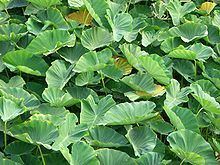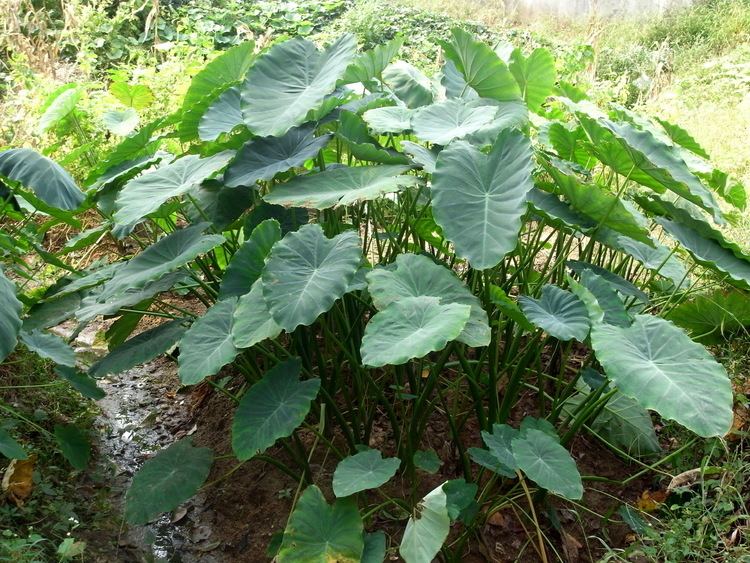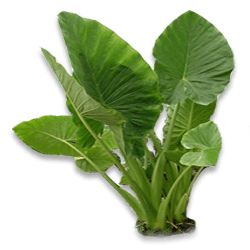Tribe Colocasieae | Subfamily Aroideae Scientific name Colocasia Rank Genus | |
 | ||
Lower classifications Taro, Eddoe, Colocasia gigantea, Small taro, Colocasia konishii | ||
Planting colocasia esculenta bulbs
Colocasia is a genus of flowering plants in the family Araceae, native to southeastern Asia and the Indian subcontinent. Some species are widely cultivated and naturalized in other tropical and subtropical regions. Common names include tarul, karkala ko ganu, elephant-ear, taro, cocoyam, dasheen, chembu, champadhumpa, shavige gadde, and eddoe. Elephant-ear and cocoyam are also used for some other large-leaved genera in the Araceae, notably Xanthosoma and Caladium. The generic name is derived from the ancient Greek word kolokasion, which in the Greek botanist Dioscorides (1st century AD) meant the edible roots of both Colocasia esculenta and Nelumbo nucifera. It is thought that the edible roots of Colocasia esculenta have been cultivated in Asia for more than ten thousand years. The species Colocasia esculenta is an invasive species in wetlands along the American Gulf coast, where it threatens to displace native wetland plants.
Contents
- Planting colocasia esculenta bulbs
- How to plant colocasia
- Species
- Ecology
- Cultivation
- Culinary uses
- In Cyprus
- In the Indian subcontinent
- In art
- References

They are herbaceous perennial plants with a large corm on or just below the ground surface. The leaves are large to very large, 20–150 cm (7.9–59.1 in) long, with a sagittate shape. The elephant's-ear plant gets its name from the leaves, which are shaped like a large ear or shield. The plant reproduces mostly by means of rhizomes (tubers, corms), but it also produces "clusters of two to five fragrant inflorescenes in the leaf axils". Like other members of the family, the plant contains an irritant which causes intense discomfort to the lips, mouth and throat. This acridity is caused in part by microscopic needle-like raphides of calcium oxalate monohydrate and in part by another chemical, probably a protease. The acridity helps to naturally deter herbivores from eating it. It must be processed by cooking, soaking or fermenting – sometimes along with an acid (lime or tamarind) – before being eaten.

How to plant colocasia
Species

- Colocasia affinis Schott - Yunnan, Nepal, Assam, Bhutan, Bangladesh, Myanmar, eastern Himalayas
- Colocasia antiquorum, sometimes considered a synonym of C. esculenta.
- Colocasia esculenta (L.) Schott - taro, elephant-ear, eddoe - native to southern China, the Indian subcontinent, Indochina, Sumatra; naturalized in other parts of Asia as well as Africa, southern Europe, South America, Central America, the West Indies, the southeastern United States, and many oceanic islands including Hawaii
- Colocasia fallax Schott - Tibet, Yunnan, Himalayas, northern Indochina
- Colocasia fontanesii Schott - Yunnan, eastern Himalayas, northern Indochina
- Colocasia gigantea (Blume) Hook.f. – giant taro - southern China, Indochina, Malaysia, western Indonesia
- Colocasia lihengiae C.L.Long & K.M.Liu - Arunachal Pradesh, Yunnan
- Colocasia mannii Hook.f. - Assam, Nicobar Islands
- Colocasia menglaensis J.T.Yin, H.Li & Z.F.Xu - Yunnan, Laos, Myanmar, Thailand, Vietnam
- Colocasia oresbia A.Hay - Bangladesh, Sabah

Ecology

Colocasia species are used as food plants by the larvae of some Lepidoptera species including Palpifer murinus and Palpifer sexnotatus.
Cultivation

C. esculenta and other members of the genus are cultivated as ornamental plants, or for their edible corms, a traditional starch staple in many tropical areas.
The plant can be grown in the ground or in large containers. They are grown outside year-round in subtropical and tropical areas. In temperate regions, they are planted out for the summer and dug up and stored over winter, dry and with ventilation to prevent fungal infection. They can be grown in almost any temperature zone as long as the summer is warm. Growth is best at temperatures between 20 to 30 °C (68 to 86 °F). The plants can be damaged if temperatures fall below 10 °C (50 °F) for more than a few days.
The root tuber is typically planted close to the surface. The first signs of growth will appear in 1 to 3 weeks. The adult plant will need a minimum of at least 1 m2 (11 sq ft) of space for good growth. They do best in compost-rich soil and in shade, but will grow reasonably well in average soil provided it is moisture-retentive. The plants should not be left to go dry for too long; if this does happen, the leaves will wilt; watering will allow the plant to recover if done before they get too dry. Periodic fertilisation (every 3 to 4 weeks) with a common plant fertiliser will increase yields.
Culinary uses
The edible types are grown in the South Pacific and eaten like potatoes and known as taro, eddoe, chamadhumpa and dasheen. The leaves are often boiled with coconut milk to make a soup which is rich in iron.
Poi, a Hawaiian dish, is made by boiling the starchy underground stem of the plant.
In Cyprus
In Cyprus, Colocasia has been in use since the time of the Roman Empire. Today it is known as kolokasi (Kολοκάσι). It is usually cooked with celery and pork or chicken, in a tomato sauce in casserole. "Baby" kolokasi is called "poulles" after being fried dry red wine is added and coriander seeds, then is served with freshly squeezed lemon. Lately some restaurants are serving thin slices of kolokasi deep fried and they call it "kolokasi chips".
In the Indian subcontinent
Both the roots and leaves are used. In Gujarat it is very famous for a recipe called "Patra" made from the leaves of Aravi. In Eastern part of Uttar Pradesh it is known as aravi ka patta. It is also a very popular dish among the Hindu community in South Africa, there also it is prepared in the same way and known as patha. In Manipur, the leaves are used to make one of the type of a Meitei ethnic cuisine, locally known as utti (pronounce as ootti). The leaves are called paangkhoklaa by the Meiteis. And the edible corms are known as paan, often used to make curries along with fermented soy beans and also use to make eromba, a famous Meitei side dish. In Odisha the root is called saru. its is an important ingredient in dalma, a popular odia cuisine.
In Mithalanchal (Bihar) the leaf is called airkanchan and they make curry of it. The root is called Arvi in most part of UP, Delhi, Punjab, Himachal Pradesh. Commonly it is boiled, peeled and mashed like potatoes and seasoned with mustard oil, green chillies and salt.
In Uttara Kannada, Hassan, Chikkamagaluru, Dakshina Kannada, Shimoga, and Udupi districts of Karnataka state, they are used to make Patrode. Also, in Chikkamagaluru, Hassan & Shimoga district, this leaf is used to make a curry, commonly known as Kesa or Kesuvina palya. This curry is most often eaten with Akki Roti.
The Sindhi Community calls the root "Kachalu". They use it as a vegetable in the well known "Sindhi curry" and also as a fried vegetable with moong dal (green gram) in a Sindhi delicacy.
In Maharashtra and Gujarat states of India the leaves as used to make a fried snack which is prepared by applying besan (gram flour) on the leaves and then frying them. In the recipe for kesa or kesuvina palya, which is native to Malenadu, the kesuvina (Colocasia) leaves are finely chopped and washed with water. Then the chopped Colocasia leaves are cooked in a pressure cooker by adding just a little water, not more than 5% of the quantity of Colocasia leaves. The leaves are cooked for almost 10 minutes or until the steam cooker attains 4-5 pressure whistles. The cooked leaves are then boiled in low flame. Meanwhile, spicy chillies, preferably jeerige menasinakayi (native to the Malenadu) and garlic are ground into a paste and added to the cooked Colocasia leaves and stirred. To this mixture, lemon extract is added, preferably 2-3 lemon extracts and cooked for 3–4 minutes. It is recommended to eat this with Akki rotti or rice with ghee.
In Kerala state, the leaves are used to make chembila curry, and the roots are used in chembu puzhukku, a traditional accompaniment to Kerala chembu. Various other recipes also exist locally. The stem and root are also used in the preparation of Ishtu and Moru curry. The leaves were also used as umbrellas during old times.In Kerala Chembu is planting on May 1 and can harvest on December of the same year.
In Tamil Nadu, it is boiled, peeled and fried and used as a side-dish with rice. In Uttarakhand the leaves are used to make a dish known as Gaabaa, whereas the stem is enclosed in Urad dal paste and dried to make Badi.
In Gujarat, this leaf is called "arvi" (or "alvi") and is used to make Patra. This is a steamed dish similar to patrode, but with gram flour instead of rice flour as in patrode.
In Andhra cuisine, the roots are boiled, peeled, and fried as an entree with rice, or they may be boiled along with a gravy called "Pulusu", and the leaves are also used.
In Maharashtra state, the leaves are used to make a sweet sour curry with peanuts and cashewnuts (a common dish made during marriages) and the leaf bases made into a side dish " Dethi" with curds.
In Nagaland, the leaves are dried, powdered, kneaded into a dough and baked into biscuits that are burnt and then dissolved in boiling water before being added into meat dishes to create a thick, flavourful dry gravy.
In Bengal, the leaves are used to wrap fish or prawns for steaming. The roots are used for a thick creamy curry, with prawns. The stem is grated with coconut and often used to create a light but flavorsome chutney.
In Pakistan, the root is called are called ARVI (in some dialects ARBI). The preparation includes frying as well as cooking with curry.
In art
In Israel, Colocasia has been in use since the time of the Byzantine Empire. The leaves are shown in mosaics from Israel as a platform, such as a plate or bowl, for serving of fruit to eat. For example at the Kursi church mosaic.
